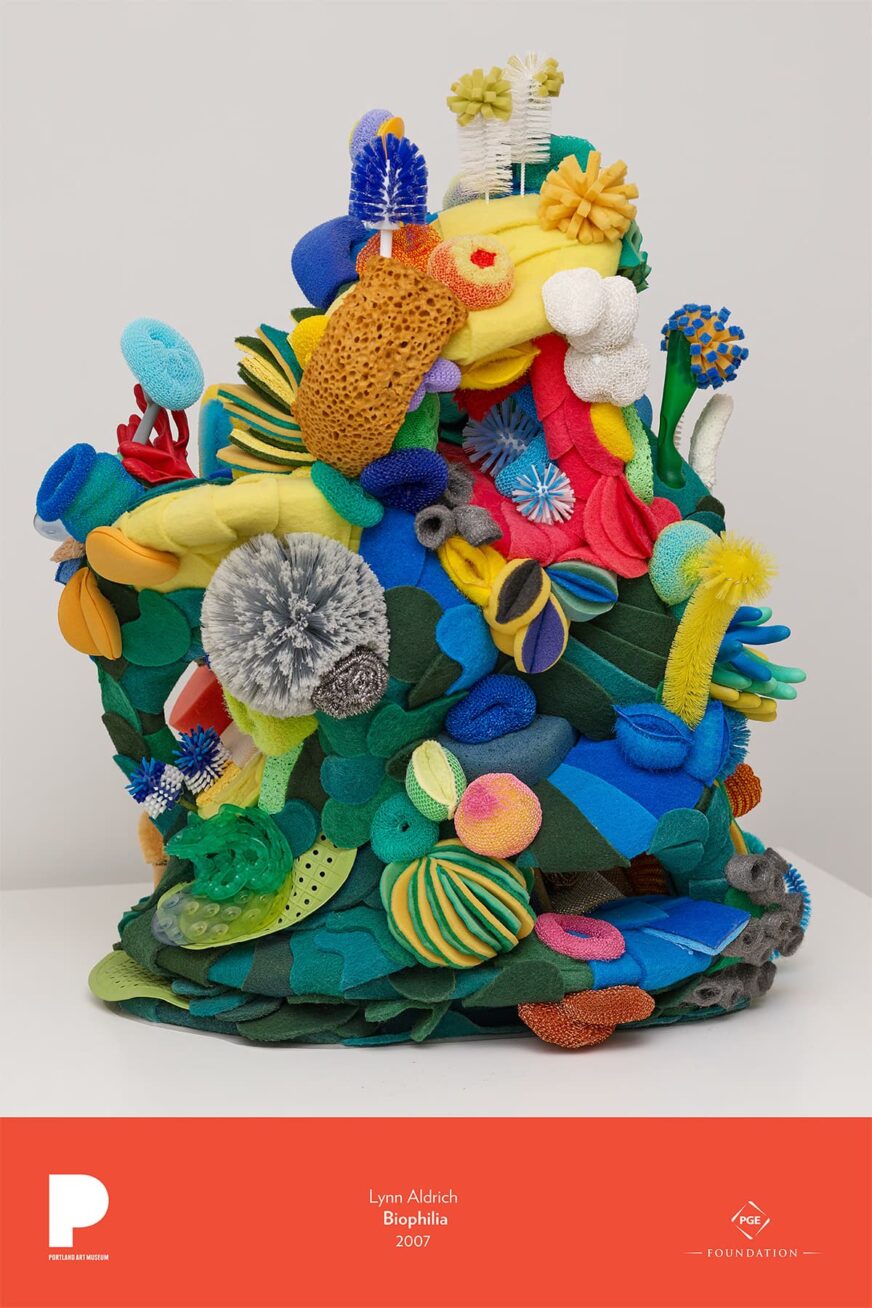
Brightly colored sponges, rubber gloves, scouring pads and scrubbing brushes pile together in the lively sculpture Biophilia. Artist Lynn Aldrich describes this work as a “miniature explosion” created to reflect the many diverse life forms of a coral reef. She bends, cuts, and links these everyday cleaning tools, shaping them into representations of vibrant sea creatures.
Aldrich has loved the natural world her entire life. As a child, she wanted to be a marine biologist. She was also influenced by reading Rachel Carson’s Silent Spring. Written in 1962, the book made a big impact on the environmental conservation movement. Today, Aldrich approaches her sculptures much like the way a scientist approaches her study subjects. To start, Aldrich looks for specimens in her surroundings. To make Biophilia, Aldrich went on a shopping spree in home goods stores and neighborhood markets in her home city of Los Angeles. She then brought everything back to her studio. Next she piled it all on the floor and spent time observing the materials until she saw relationships of shape and color that suggested underwater life forms. Finally, she transformed the variety of parts and assembled them together to create something evocative and new.
Biophilia is both fun and serious. The title itself is a compound noun that joins the Greek root words “bio,” meaning life, and “philia,” meaning love. The title can be read as “love of life,” and the sculpture is certainly a joyful tribute to the abundance of creation and the awesome variety of life forms. The artist also connects her work to important environmental issues, especially the plastics that pollute oceans and landfills. By replacing delicate living creatures with artificial objects, this work asks us to think about how our actions endanger the reefs and the oceans. Aldrich also points out that the harmful presence of plastic waste in the ecosystem results from our contemporary consumer culture built on cheap, abundant, and disposable goods. Nonetheless, the artist is drawn to these “worthless” materials (as she calls them) and transforms them into an artwork that captures the imagination. The sculpture makes a sharp statement by using cleaning tools to depict an ecosystem that needs to be cleansed and repaired of human-caused damage.
Discussion and activities
- Look closely at the picture of this sculpture by Lynn Aldrich. What does it make you think of? Can you identify some of the materials and objects in the sculpture? Why do you think Aldrich chose to create her sculpture out of everyday objects and, specifically, cleaning supplies? What connections can you think of between cleaning supplies and a coral reef?
- The title of this sculpture is Biophilia, a word that brings together the Greek root words “bio,” meaning life, and “philia,” meaning love. In what ways does this sculpture express “love of life”? Is the title ironic, sincere, playful, all of the above? Explain how.
- One of Aldrich’s goals with this sculpture is to make us think about our global environmental crisis and, specifically, the impact of human- caused pollution on ocean life. Think of an environmental issue that is meaningful to you (wildfires, the melting of the polar ice caps, the destruction of the Amazon rainforest, the pollution of rivers and streams, etc.). What is the most important thing for people to understand about your issue? What do you think is most likely to persuade them to care about it and even take action? How would you raise awareness about this environmental issue through art? What medium and/or materials would you use? Would your tone be serious or playful or both? Now, go out and make it.
*For an added challenge and to get a deeper understanding of Aldrich’s technique, try creating your work out of found objects— everyday materials you have at home or in the recycling bin. - Compare Lynn Aldrich’s sculpture Biophilia to Will Wilson’s photograph Auto Immune Response No. 2, also featured in the Poster Project. These two artists are both thinking about environmental crises and are raising awareness through art, but with completely different approaches. Create a table with two columns and lay out some of the things these works have in common and some of their differences. What makes each of these works effective?
Recommended resources
- Lynn Aldrich
- Lynn Aldrich: Uncommon Artist. Directed by John Schmidt. 2016.
- Shorb, John. I Could Never Be a Bodhisattva: An Interview with Lynn Aldrich. SARTS: Society for the Arts in Religious and Theological Studies.
- May, Tiffany. Hidden Beneath the Ocean’s Surface, Nearly 16 Million Tons of Microplastic. New York Times. October 7, 2020.
Spanish-language PDFs developed with the support and collaboration of
